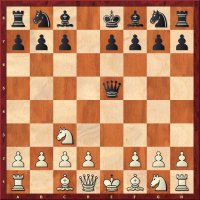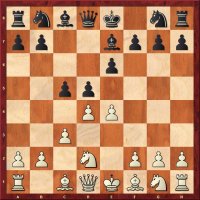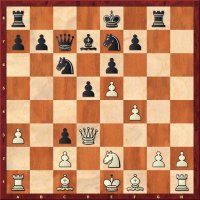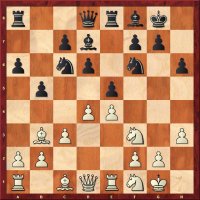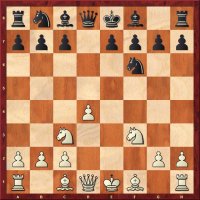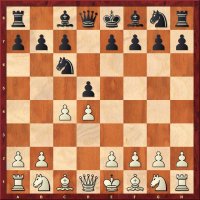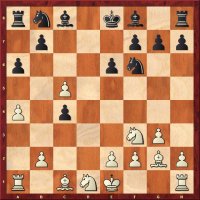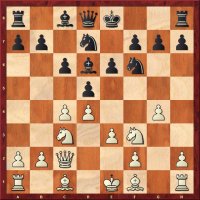 | Introductory videos In his introductory video GM Karsten Müller gives you a first insight into the varied content of the DVD, e.g. Karjakin’s first round victory in Wijk over Morozevich or the may interesting openings articles, e.g. on the Blackmar Diemer Gambit, a surprise weapon against the Sveshnikov, the Centre Counter with 3...Qe5+, 2.Ne2 against the Najdorf system or a rare idea against the Leningrad System in the Dutch Defence. |
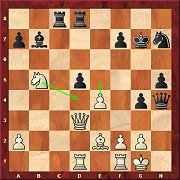
| GM Dorian Rogozenco devotes his first introductory video for this issue to the tournament highlights of Wijk an Zee and Linares. This includes making clear by an examination of the game Carlsen - Karjakin just how good the defensive arts of the later winner of the tournament really are. He also shows how Short lost his chance of victory in the B-tournament in his final round game against Caruana. As far as Linares is concerned, Rogozenco explains Grischuk’s textbook treatment of the middlegame against Aronian (see diagram) and the tricky rook ending from the game between Ivanchuk and Anand. |

| In his second video Rogozenco reviews the match between Topalov and Kamsky for the right to challenge World Champion Anand. The focus is on the Romanian grandmaster Topalov’s three victories, especially those critical positions in which his challenger made unusually clear mistakes which led to him giving away the draw or even the win. In conclusion Rogozenco demonstrates one brilliant game each from the top-class Opens in Moscow and Gibraltar as well as from the German Individual Championship. |
17.01.-01.02.2009 
| Wijk an Zee Sergey Karjakin was the surprise winner of this year’s edition of the strongly traditional top Dutch tournament. In the final round, with Black, Karjakin bet everything on a single card against his fellow front runner Dominguez and was rewarded with undivided first place in the tournament. On the DVD the young Ukrainian annotates two of his victories. You will find an extensive tournament report and all the games from Wijk via the browser list. |
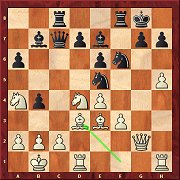
Karjakin,S - Morozevich,A
Position after 18.Bd3
| Karjakin started his tournament with a win in the first round. In a Sicilian Paulsen Variation Morozevich played "his" move 8...Be7 and obviously ran straight into his opponent’s preparation. Karjakin inserted two good prophylactic moves in 13.Kb1 and 15.Qg2 and was happy with the result of the opening phase after 18.Bd3. The semi-open g-file cries out for an attack on the opposing king. And on the other side it is difficult to make out how Black can develop any counterplay. By only move 22 Morozevich had made a decisive error and soon had to capitulate on account of the massive white attack down the g- and h-files. |

Karjakin,S - Adams,M
Position after 14.cxb4
| With his victory over Adams in the last round but one Karjakin joined the group of leaders. Here too the Ukrainian managed to come out of the opening on favourable terms with an (almost) new move (see diagram). He then made the most of the fact that his opponent did not find the best way to handle the position. After Adams played 19...Rb8 White got a strong pawn queenside phalanx which left the black minor pieces – especially the bishop on b7 – looking quite weak. Click here or under the diagram and Karjakin will explain to you his impressive winning play. |
 | Last year’s victor Magnus Carlsen was of course one of the favourites in this year’s field – but the young Norwegian was unable to score his first win before round 10. When one gets down to it, there were too many unexploited chances in the first half of the tournament for a successful title defence. Carlsen managed a convincing victory over the Dutch player Jan Smeets in the penultimate round. |

Carlsen,M - Smeets,J
Position after 28.b4
| In this game Carlsen aimed to get into lesser known territory quickly with 2.c4 against the Caro-Kann. His analysis of this game is very instructive and brings out clearly the tough struggle for a minimal advantage and the initiative. In playing 11.Bd3 Carlsen deviated from the previous game Ivanchuk - Topalov, which had led to a draw just before in Nanjing. The knight on a5 soon became a problem piece for Black. Carlsen went on to succeed in mounting more and more pressure on the black position and with 28.b4 (see diagram) made the decisive thrust. Can you see what White has up his sleeve after 28...Nb7? |
 | Plus ça change... In ChessBase Magazine 128 Loek van Wely presented in the most entertaining fashion on video his win with White against Radjabov’s King’s Indian from the Chess Olympiad. In Wijk the Dutch grandmaster once more had the good fortune to have White against Radjabov. Once again he had a convincing win, of course against the latter’s King’s Indian, and once again van Wely’s analysis in this issue is both entertaining and humorous. |

Van Wely,L - Radjabov,T
Position after 24.Qh3
| In a classical King’s Indian van Wely quite obviously managed to surprise his opponent with 11.Rb1 – a very rare move, with which Ponomariov had gone down against Radjabov six years ago at the same tournament. Radjabov was not able to cope properly with van Wely’s innovation 20.h4 and soon decided on the wrong plan, as a result of which his king was soon in extreme peril. With the quiet move 24.Qh3 (see diagram) White obliged his opponent to exchange on h6 and by doing so to almost completely laid his king bare. After both rooks came into action on the f-file, the Azerbaijani was obliged to strike his colours only a few moves later. |
 | Teimour Radjabov’s King’s Indian duel with the Chinese GM Wang Yue(which would be continued in Linares) would turn out more successfully for Black.Radjabov did not achieve a decisive advantage in this game until the endgame, when, with the pawn sacrifice 26...e4 which is well worth seeing, he freed his King’s Indian bishop and went on to seize the initiative with his rooks on the a-file and the semi-open b-file.
Wang Yue - Radjabov,Tto play through. |

Radjabov,T - Kamsky,G
Position after 41.Bd6
| In his game against Kamsky, Radjabov played the rare 5.Nc5 against the Caro-Kann, but this only brought him a very slight opening advantage. In his analysis Radjabov explains his efforts to develop an initiative on the queenside, the undogmatic exchange of his fianchettoed bishop and the tactical complications from which he emerged into the endgame of rook and bishops of opposite colours with two extra pawns. Karsten Müller has examined in detail the subtleties of this ending in his Endgame column. The complete game with Radjabov’s analysis can be found here. |
| 17.02.-26.02.2009 
| World Chess Challenge Sofia The victor of the "World Chess Challenge" and thus the next challenger of World Champion Vishy Anand is Veselin Topalov, who started the match against Gata Kamsky as the clear favourite. You will find on the DVD all the games in the match with extensive commentary. The American was able to keep the match level as far as the half-way mark. But in his first two games with the French in rounds 5 and 7, Kamsky went wrong after successful opening play and because of this he had to concede defeat before the final game of the match. |

Topalov,V - Kamsky,G (7)
Position after 31.Qb7
| The game in round 7 was symptomatic for the match as a whole. Kamsky demonstrated good preparation and with his innovation 13...Qb6 he put the white position under pressure. As the middlegame advanced, he even managed to achieve an advantage – but to do so he invested too much time and lost control and lost track of things in the complications initiated by Topalov towards the end. In the position in the diagram Kamsky chose the wrong move order with 31...Reb8 – 31...b4 32.d7 Reb8 would have won and would have opened up the match completely again. Click here or on the link under the diagram to play through the game with the analysis of GM Igor Stohl. |
19.02.-07.03.2009 
| Linares Though they were on equal points, Alexander Grischuk won the super-tournament in Linares ahead of Vassily Ivanchuk thanks to having a greater number of wins. All the games and an extensive tournament report can be found here or via "Linares 2009" above in the browser list. The most important games can be found annotated on the DVD by Krasenkow, Rogozenco, Kritz, etc. |
 | Annotating for us for the first time is 14 year old Anish Giri. At the end of January Giri came in joint second in the C-group in Wijk and in doing so scored his final GM norm. This makes him the youngest grandmaster in the world at this time. In the German Bundesliga our young shooting star (with Nepalese-Russian roots and who lives in the Netherlands) has been appearing this season for SK Turm Emsdetten. |

Carlsen,M - Wang Yue
Position before 24...Rxb6
| Giri annotates for the DVD five games from Linares, including two by Magnus Carlsen, which serve as examples of his variable form in that tournament. In round 10 the young Norwegian tried to rattle his opponent, Wang Yue, with 7.Bd2 against the Slav with a6. But he was wide of the mark, and the Chinese player rapidly seized the initiative with 10...e5. In the position in the diagram, Wang Yue bet all on a single card with the exchange sacrifice on b6. His courage was rewarded, because after 25...Qe5 Carlsen could not find the correct defence. Anish Giri annotates the game in detail from the start right up to the final hunt of the white king over half of the board. |
| 03.10.2008-29.3.2009 
Feygin - Shirov
Position after 25...a5
| Bundesliga 2008/09 Alexei Shirov is often in Germany and for a long time he has enjoyed playing in the Bundesliga. There are various reasons for this, but one of them is certainly that in the Bundesliga he has usually won his games and played some most beautiful ones. The present season did not start in the best possible way for him, but in the final rounds the pleasant naturalised Spaniard had a series of victories which are well worth seeing. Shirov annotates two of them extensively on video for this DVD. In his game against Feygin they got right down to business in the very opening. After only 8 moves Shirov was out of his opening book and he decided to cut across his opponent’s preparation with the help of an unusually early queenside advance. Click here to have Shirov explain the whole game to you on video. |

Shirov - Landa
im Videoformat | In his game against Landa, Shirov did not have enough preparation time and so turned to 1.d4, in order to avoid Landa’s Petroff Defence and the risk of an early draw. In the Catalan Opening he went on to choose in 8.a4 a variation with which Gelfand had caused him some problems in the Olympiad. In his video analysis Shirov also goes into this game in detail and explains how the understanding of the opening and middlegame ideas from the earlier game helped him in his victory over Landa. |
| 
13.Nxb5 against the Sveshnikov
| Surprise weapons with or against the Sveshnikov In addition to the 11 extensive openings articles on the DVD and in the booklet, this issue has for you two shorter repertoire suggestions in video format. ChessBase colleague Pascal Simon presents in conjunction with IM Oliver Reeh an attractive piece sacrifice, which gives White an initiative and three strong queenside pawns in the Sveshnikov Variation. It is particularly recommended to ambitious club players, who would like for once to give their opponents a right going over in their favourite variation. |

12...Ba6 for friend of the Sveshnikov
| Dorian Rogozenco presents in video format a rarely played idea in the Classical Sicilian, which is interesting not only for but especially for friends of the Sveshnikov. If you are aiming for the Sveshnikov with a more flexible move order (2...e6), then after 5...Nc6 you are often confronted with 6.Nxc6. At the end of the mainly forced sequence which follows, Rogozenco suggests the move 12...Ba6, which offers Black a good game and at the same time sets White a series of specific problems. As a supplement to the video, Rogozenco contributes to the DVD two extensively annotated games. |

























